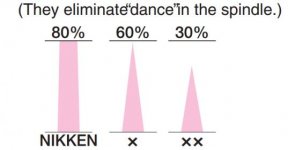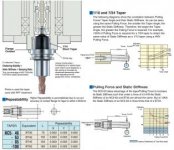deadlykitten
Banned
- Joined
- Aug 5, 2016
hello, i just finished my 1st tool change procedure for the mill ; i did not attached it to a G code ( macro ) yet 
actually, i do not know how
availabes syntaxes :
CALL OCHG VC190=active tool VC191=next tool
CALL OCHG VC190=active tool
CALL OCHG VC191=next tool
CALL OCHG
... it moves spindle to right if above senzor
... after "next tool" is prepared, M64 comes in, to avoid magazine "lift up" during cutting
... it handles EMPTY values, in case a variable gets "nill" ? or how would you call it ? kindly !

actually, i do not know how

availabes syntaxes :
CALL OCHG VC190=active tool VC191=next tool
CALL OCHG VC190=active tool
CALL OCHG VC191=next tool
CALL OCHG
... it moves spindle to right if above senzor
... after "next tool" is prepared, M64 comes in, to avoid magazine "lift up" during cutting
... it handles EMPTY values, in case a variable gets "nill" ? or how would you call it ? kindly !
Code:
OCHG
( ~ ~ ~ ~ ~ ~ ~ ~ ~ ~ ~ ~ ~ ~ ~ ~ ~ ~ ~ ~ ~ ~ ~ ~ ~ ~ ~ ~ ~ ~ ~ ~ ~ ~ ~ )
( 0 to EMPTY's )
( ~ ~ ~ ~ ~ ~ ~ ~ ~ ~ ~ ~ ~ ~ ~ ~ ~ ~ ~ ~ ~ ~ ~ ~ ~ ~ ~ ~ ~ ~ ~ ~ ~ ~ ~ )
IF [ VC190 NE EMPTY ] N1
VC190 = 0
N1
IF [ VC191 NE EMPTY ] N2
VC191 = 0
N2
( ~ ~ ~ ~ ~ ~ ~ ~ ~ ~ ~ ~ ~ ~ ~ ~ ~ ~ ~ ~ ~ ~ ~ ~ ~ ~ ~ ~ ~ ~ ~ ~ ~ ~ ~ )
( active tool )
( ~ ~ ~ ~ ~ ~ ~ ~ ~ ~ ~ ~ ~ ~ ~ ~ ~ ~ ~ ~ ~ ~ ~ ~ ~ ~ ~ ~ ~ ~ ~ ~ ~ ~ ~ )
IF [ VC190 EQ VTLCN ] NA1 ( if "desired tool" is allready in spindle )
IF [ VC190 NE 0 ] NA2 ( if empty spindle is not desired )
IF [ VTLNN EQ 0 ] NA3 ( if there is no "next tool" )
M64 ( lift down )
NA3 M63 ( find an empty pot )
M6 ( switch > empty spindle )
GOTO NA1
NA2
( if "desired tool" is allready prepared,or )
( if there is no "next tool" )
IF [ [ [ VC190 EQ VTLNN ] OR [ VTLNN EQ 0 ] ] EQ 1 ] NA4
M64 ( lift down )
NA4 T = VC190 M6 ( switch > "desired tool" )
NA1
( ~ ~ ~ ~ ~ ~ ~ ~ ~ ~ ~ ~ ~ ~ ~ ~ ~ ~ ~ ~ ~ ~ ~ ~ ~ ~ ~ ~ ~ ~ ~ ~ ~ ~ ~ )
( go play )
( ~ ~ ~ ~ ~ ~ ~ ~ ~ ~ ~ ~ ~ ~ ~ ~ ~ ~ ~ ~ ~ ~ ~ ~ ~ ~ ~ ~ ~ ~ ~ ~ ~ ~ ~ )
IF [ VTLCN EQ 0 ] NA4
G56 HA DA
NA4
( ~ ~ ~ ~ ~ ~ ~ ~ ~ ~ ~ ~ ~ ~ ~ ~ ~ ~ ~ ~ ~ ~ ~ ~ ~ ~ ~ ~ ~ ~ ~ ~ ~ ~ ~ )
( spindle to right )
( ~ ~ ~ ~ ~ ~ ~ ~ ~ ~ ~ ~ ~ ~ ~ ~ ~ ~ ~ ~ ~ ~ ~ ~ ~ ~ ~ ~ ~ ~ ~ ~ ~ ~ ~ )
CALL ORGHT
( ~ ~ ~ ~ ~ ~ ~ ~ ~ ~ ~ ~ ~ ~ ~ ~ ~ ~ ~ ~ ~ ~ ~ ~ ~ ~ ~ ~ ~ ~ ~ ~ ~ ~ ~ )
( next tool )
( ~ ~ ~ ~ ~ ~ ~ ~ ~ ~ ~ ~ ~ ~ ~ ~ ~ ~ ~ ~ ~ ~ ~ ~ ~ ~ ~ ~ ~ ~ ~ ~ ~ ~ ~ )
IF [ VC191 EQ VTLNN ] NN1 ( if "desired next tool" allready prepared )
IF [ VTLNN EQ 0 ] NN2 ( if there is no "next tool" )
M64 ( lift down )
NN2
IF [ VC191 EQ 0 ] NN1 ( if no "next tool" is desired )
T = VC191 ( "desired next tool" gets prepared )
M64 ( lifting during cutting should be avoided )
NN1
( ~ ~ ~ ~ ~ ~ ~ ~ ~ ~ ~ ~ ~ ~ ~ ~ ~ ~ ~ ~ ~ ~ ~ ~ ~ ~ ~ ~ ~ ~ ~ ~ ~ ~ ~ )
( master reset )
( ~ ~ ~ ~ ~ ~ ~ ~ ~ ~ ~ ~ ~ ~ ~ ~ ~ ~ ~ ~ ~ ~ ~ ~ ~ ~ ~ ~ ~ ~ ~ ~ ~ ~ ~ )
VC190 = 0 VC191 = 0
RTS
Code:
ORGHT
IF [ VTLCN EQ 0 ] GOTO N1
GOTO N2
N1 MOVE = 200
GOTO N3
N2 MOVE = 200 + VTOFD [ VTLCN ] / 2
GOTO N3
N3
IF [ VWKAX + VZOFX [ VACOD ] GE - 751 + MOVE ] NSKIP
IF [ VWKAY + VZOFY [ VACOD ] LE + 331 - MOVE ] NSKIP
G00 Z9999
G00 X - 751 + MOVE - VZOFX [ VACOD ]
( G00 Y + 331 - MOVE - VZOFY [ VACOD ] )
NSKIP
RTS
Last edited:





